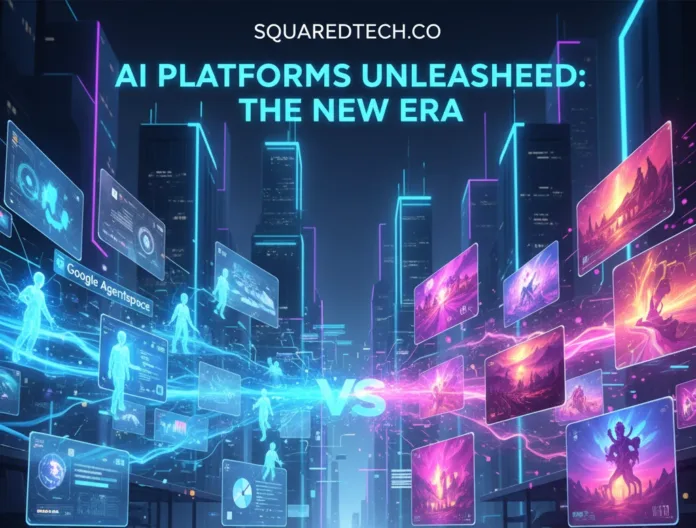Table of Contents
Google Agentspace: The Next Frontier in AI Agents
Google Agentspace is Google’s new framework for building and deploying AI agents. These agents act as autonomous digital workers that can process data, analyze tasks, and interact with other systems on behalf of users.
At Squaredtech, we see this launch as a major step in Google’s strategy to expand AI utility from chatbots into specialized business agents. Unlike chat-based AI, Agentspace focuses on action-based workflows. An agent can read data, interpret instructions, and execute tasks in real time.
How Google Agentspace Works
Agentspace is powered by Google’s AI models, which combine language understanding, reasoning, and action execution. Developers can:
- Define a role – Example: sales assistant, research bot, customer support helper.
- Set rules and context – Input structured instructions, boundaries, and goals.
- Connect APIs and tools – Agents interact with CRMs, analytics dashboards, or email platforms.
- Train on data – The more company-specific context an agent has, the better it performs.
- Test and deploy – Agents run in controlled environments before going live.
This step-by-step structure makes Agentspace less technical than traditional AI development. Google wants enterprises to adopt it without requiring heavy coding skills.
Check Out Latest Article of OpenAI’s Game-Changing Move: Sora Video Generator Coming to ChatGPT December 14th, 2025 – SquaredTech
Agentspace vs Other AI Agent Platforms
There are already multiple AI agent platforms, but Google Agentspace introduces three differentiators:
| Feature | Google Agentspace | OpenAI Agents | Anthropic Claude Agents | AutoGPT |
|---|---|---|---|---|
| Ease of Setup | High | Medium | Medium | Low |
| Integration | Google Workspace, APIs, Cloud | OpenAI APIs | Claude API | Open-source, scattered |
| Scalability | Enterprise-ready | Growing | Experimental | Community-based |
| Safety Controls | Built-in, strict | Moderate | Strong but limited tools | Limited |
Analysis from Squaredtech:
- Google is pushing workplace adoption by tying Agentspace to existing Google Cloud and Workspace ecosystems.
- Compared to OpenAI’s agent tools, Agentspace emphasizes compliance and enterprise control, which matters for large companies.
- Unlike AutoGPT, which is experimental, Agentspace focuses on reliable business use cases.
Enterprise Use Cases of Google Agentspace
Businesses are already experimenting with Agentspace in multiple industries.
- Sales: Agents track leads, update CRM entries, and send follow-up emails.
- Research: Agents summarize papers, extract insights from data, and provide structured reports.
- Customer Support: Agents act as first-line support, resolving FAQs before escalating.
- Project Management: Agents handle scheduling, task updates, and resource allocation.
For enterprises, Agentspace is about automation with accountability. Agents log actions and provide visibility, which makes management easier.
MidJourney V7: Image-to-Video Transformation
While Google is advancing AI agents, MidJourney is moving from static images into video generation with its V7 release.
MidJourney V7 expands its image engine into video. It takes a still image prompt and animates it with motion, depth, and transitions. This makes MidJourney a bridge between AI art and AI filmmaking.
Check Out Latest Article of Google Photos with Veo 3 Integration: AI Tools That Transform Photos and Videos September 14th, 2025 – SquaredTech
How Image-to-Video Works in MidJourney V7
- User provides an image or prompt.
- The model creates depth maps and movement paths.
- Frames are generated and stitched into continuous video.
- Users can refine with styles: cinematic, anime, or realistic.
This feature is similar to OpenAI’s Sora 2 and Google’s Veo 3, but MidJourney V7 focuses more on artistic animation rather than photorealism.
How to Animate MidJourney Images
Users can animate MidJourney images in a few steps:
- Create an image using the MidJourney prompt.
- Select the V7 Animate option in the interface.
- Adjust movement intensity, direction, and frame length.
- Export video clips for editing or sharing.
The simplicity makes V7 appealing for creators without deep technical knowledge.
MidJourney V7 vs Sora 2 vs Veo 3
Check Out Latest Article of Midjourney V7 Launches: Faster AI Image Generation With Personalization April 5th, 2025 – SquaredTech
| Feature | MidJourney V7 | OpenAI Sora 2 | Google Veo 3 |
|---|---|---|---|
| Focus | Artistic animation | Realistic video | Cinematic accuracy |
| Strength | Creativity and style | Physics realism, synced audio | High-quality cinematography |
| Weakness | Less realistic | Limited access | Restricted availability |
| Target Users | Artists, designers | Professionals, studios | Filmmakers, researchers |
Squaredtech Analysis:
- MidJourney V7 is best for artistic freedom.
- Sora 2 and Veo 3 are chasing real-world video replacement.
- The gap between art-driven AI and production-driven AI is becoming clearer.
Copyright Issues with AI Video and Images
AI-generated content raises copyright challenges. Users often ask:
- Can AI videos use copyrighted styles?
Yes, but companies like MidJourney and OpenAI restrict direct use of celebrity likenesses or branded content. - Who owns AI-generated media?
Typically, the user holds rights, but platforms can claim shared usage rights. - How can businesses stay safe?
Squaredtech recommends watermarking, checking platform policies, and avoiding direct replication of copyrighted material.
MidJourney API: What It Could Do
An upcoming MidJourney API could allow developers to:
- Automate video generation workflows.
- Integrate AI visuals into websites, apps, or games.
- Enable bulk content creation for marketing or design.
If released, this API would push MidJourney closer to OpenAI’s ecosystem model.
Predictions: The Future of Agents and AI Video
Based on current trends, Squaredtech predicts:
- Google Agentspace will dominate enterprise AI agent adoption due to cloud integration.
- MidJourney will grow in creative industries, especially for indie creators and design studios.
- Generative video tools like Sora 2, Veo 3, and MidJourney V7 will converge, but each will specialize.
- Compliance, copyright, and licensing will become major regulatory topics in 2026.
FAQs (Answer the Public + People Also Ask)
What is Google Agentspace?
It is Google’s platform for building AI agents that can automate workflows in business and enterprise settings.
Is Google Agentspace free?
Currently, it is integrated with Google Cloud and may require enterprise-level access.
What can you do with Agentspace?
You can build sales agents, research assistants, customer support bots, and task managers.
What is MidJourney V7?
MidJourney V7 is the latest version of the AI art platform, now with video generation.
Can MidJourney create full movies?
Not yet. It can animate short clips, but cinematic production requires additional editing.
Is MidJourney better than Sora 2?
For creative animations, yes. For realistic video, Sora 2 is more advanced.
Will AI replace filmmakers?
AI will support rather than replace. Directors will still guide storytelling, but AI will speed up visual production.
Conclusion
Google Agentspace and MidJourney V7 represent two major directions in AI. Agentspace focuses on autonomous business agents, while MidJourney V7 pushes AI creativity into motion. Both highlight how AI is expanding into daily workflows, from enterprise automation to artistic production.
At Squaredtech, we believe this convergence of agents and generative media will define the next phase of AI adoption across industries.
Stay Updated: Artificial Intelligence


